| Home | Presses | Intro | Site Map | P.R. | Chemicals | Answers |

|
| Prices | Specials | How To | Bullets | B.Makers | Books | Classified | |
| Topics | Jackets | Terms | Training | Software | Products | Contact us |
| Home | Presses | Intro | Site Map | P.R. | Chemicals | Answers |

|
| Prices | Specials | How To | Bullets | B.Makers | Books | Classified | |
| Topics | Jackets | Terms | Training | Software | Products | Contact us |

|
|
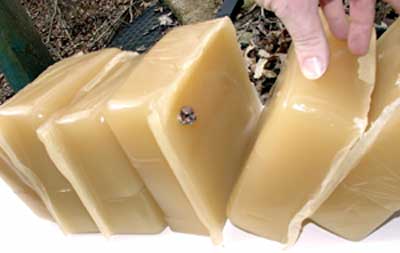 Corbin SIM-TESTtm Ballistic Media
Corbin SIM-TESTtm Ballistic Media
Corbin SIM-TESTtm ballistic test media is a stable, animal-protein based "simulated tissue" for consistent bullet performance tests. The material is a very close match to muscle tissue in density and consistency. The density is 1.3 gm/cc. (Density can be adjusted by controlling water content.) The major advantages over ballistic gel is stability at room temperature, and nearly unlimited re-use (melt and re-cast), which makes it a long term investment instead of a one-use throw-away. You may have seen episodes of "CSI" or "Myth Busters", where entire human torsos or body parts were molded from Sim-Test and used in forensic experiments. Sim-test has also been used by Naval Research Labs, Department of Energy, COSI, John Hopkins University, and other ballistic labs, medical research facilities, and even hypodermic needle testing and protective body armor and helmet testing. Inserting acceleration gauges and impact sensors directly into castings of the material, which melts at about 140-deg. F, allows precision simulation and testing of the effects of impacts through protective clothing. |
|
| SIM-TESTtm has these advantages over wet newspaper, water, clay, conventional ballistic gellatin, and other test materials commonly used as a bullet expansion medium: | |
|
|
Corbin Simulated Animal Muscle Tissue Ballistic Test Media (SIM-TESTtm) is an animal-protein based gel that is solid at room temperature, and can be easily melted and re-cast by using hot water in a double boiler. The low melting temperature means that very little heat is required to re-form the blocks after firing tests. The simulated muscle tissue is more consistent in density and structure than wet paper, clay, or other water-saturated materials.
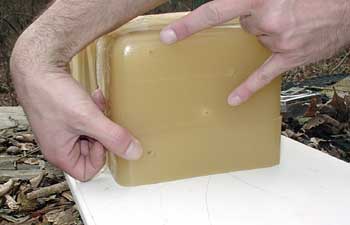 The material can be damaged by over-heating. Use only the minimum amount of heat required for re-casting. Overheating causes the material to become darker, with embrittlement and loss of elasticity eventually developing. An anti-bacterial agent has been incorporated in the formula to preserve the material and retard deterioration in storage. Refrigeration or storage in a cool, dry environment will extend the useful life.
The material can be damaged by over-heating. Use only the minimum amount of heat required for re-casting. Overheating causes the material to become darker, with embrittlement and loss of elasticity eventually developing. An anti-bacterial agent has been incorporated in the formula to preserve the material and retard deterioration in storage. Refrigeration or storage in a cool, dry environment will extend the useful life.
SIM-TESTtm is made from the same basic building blocks as the living tissue that it simulates, and has been in use by forensic labs, police crime labs, and by serious ballisticians involved in defense and wound ballistic studies, as an easier to use substitute for refrigerated ballistic gellatin. For testing hunting bullets, SIM-TESTtm can be placed in stacks within a retaining structure, such as a sturdy wood or metal container with an opening that exposes the surface of the material for shooting. It is sold in 10-lb blocks which can be placed in a row, with the thickness of four inches for each 250 feet per second of expected bullet impact speed. The row of blocks should be backed up by a back stop sufficient to trap the bullet by itself (such as an angled plate, snail bullet trap, or thick wood planks backed by steel). Users are presumed to know and follow standard safety precautions just as they would without the use of the test media. 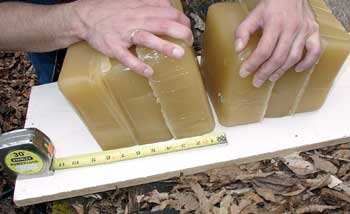 A typical purchase for a custom bullet maker would be one or two cartons, each of which holds six blocks weighing just a little under 10 pounds each. A carton typically weighs 54 to 60 pounds. The contents of two cartons is normally sufficient to stop any typical small arms hunting or target projectile, but precaution should be taken to allow for the possibility of complete penetration through all blocks. Storage in damp, hot environments will accelerate deterioration, and should be avoided. The material is shrink wrapped, and should be unwrapped for use as needed, then re-wrapped or cast into air-tight containers and stored in a cool, dry area. Refrigeration is desirable but not necessary. Avoid freezing and thawing cycles.
A typical purchase for a custom bullet maker would be one or two cartons, each of which holds six blocks weighing just a little under 10 pounds each. A carton typically weighs 54 to 60 pounds. The contents of two cartons is normally sufficient to stop any typical small arms hunting or target projectile, but precaution should be taken to allow for the possibility of complete penetration through all blocks. Storage in damp, hot environments will accelerate deterioration, and should be avoided. The material is shrink wrapped, and should be unwrapped for use as needed, then re-wrapped or cast into air-tight containers and stored in a cool, dry area. Refrigeration is desirable but not necessary. Avoid freezing and thawing cycles.
SIM-TESTtm is non-toxic, has a very low incidence of reaction except for rare cases of sensitivity, is non-flammable, boils at 100-deg. centigrade, and has no known health hazards associated with handling or use. It has a faint odor similar to vanilla, and feels "rubbery". If bullet fragments contaminate the material, it can be cleaned by melting and decanting, or by dissolving in water and then after pouring into another container, evaporating the water at low heat over a period of hours. SIM-TESTtm Cat.No. ST-6, Carton, aprox. 54-60 lbs (6 blocks) SIM-TESTtm Cat.No. ST-1, Block, aprox. 8.9-9.8 lbs |
|
|
Tips for using SIM-TESTtm: 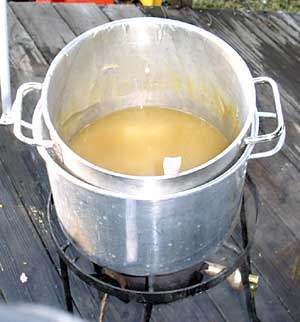
| |
|
by Col.K.C.Duran Bullet testing is more of an art than a science, even though it may be done in a lab under controlled conditions. The reason is that the actual field conditions are virtually impossible to duplicate in the lab, because they seldom repeat themselves twice in the field! How can you duplicate constantly changing conditions? In the forensic field, for example, a bullet may impact a person through a heavy coat or on bare skin. It may strike a bone straight on, or it may glance along a bone and follow a long path under the skin, emerging somewhere else on the body that would hardly be expected. It may miss every bone in the body and impact nothing but muscle tissue, or it may even miss most of the muscle and puncture the space between organs, without striking anything you'd have to spell on a high school biology test. The problem with bullet testing is that we don't always know exactly what we are testing against, or for. In forensics, the idea may be to just recover the bullet with as little damage as possible, so it can be compared to a bullet used in a crime. That is not really "testing" in the sense of finding out what a bullet can do, so much as "testing" the appearance of one bullet against another, to try and discover whether both were fired from the same gun, or perhaps to get some idea of the kind of gun that was used to fire it. But a custom bullet maker who is testing a bullet isn't trying to solve a crime. Instead, the idea is to try and see how well the bullet performs in comparison with the performance of other bullets that customers could purchase. And that is where the problem starts: what exactly do we consider "better" performance? The performance we would like to see depends on the purpose for which the bullet will be used. Some bullets will be used for personal defense, some for hunting, and some for target shooting, to name the "big three" out of many possible uses. Target shooting is one of the easy things to evaluate: you want the most accurate bullet for the kind of gun and load, at the intended range to the target, for most of the people who will be using the bullet. In some cases, the most accurate bullet for one load and gun is not even close to accurate enough for another gun and load. The Ultra Low Drag or the Very Low Drag designs, which generally feature a long secant ogive and a rebated boattail (ULD) or a standard boattail (VLD), may be terribly unstable in a normal 10 or 12 inch per turn "factory" standard barrel, although they may be the most flat shooting and therefore most likely to stay on the 10-ring at 1000 yards when fired from a fast-twist barrel with a fairly high initial velocity. Likewise, the bullet designed to penetrate half-way through a deer-sized animal and expand to twice its diameter almost every time, without losing its core (by using Core Bond, for example, or by using a double-jacket design where one jacket protects the core inside the airframe of the other jacket) may just poke a hole all the way through a fox or coyote without expanding until it hits the dirt on the other side. And it may blow to bits within milliseconds of striking the tough skull and horns of a Cape Buffalo. So, what is "better"? If your bullet expands to a classic mushroom shape at 3,200 fps impact velocity, is that good or not? If it penetrates twice as far as a factory bullet, is that better or worse? The answer is, there isn't enough data to tell! In the first instance, we have not compared the bullet to any alternative bullet. Maybe the alternative, in the same circumstances, blows to bits. Then the test sample is better, assuming you didn't want a fragmenting bullet for some reason. Maybe the alternative bullet would expand even larger at the same speed, or reach that size and stay there at 2,900 fps instead of 3,200 fps. In that case, maybe the test bullet isn't quite as "good". But we really don't know enough yet. It's almost as if we said, "This vehicle gets 20 miles to a gallon. Is that good?" Could be, if it is a heavy truck or a big police cruiser. Maybe not, if it is a light-weight two-seater. Besides, there is a lot more to compare than just gas mileage before we make any over-all value judgement. In the second case, we have not determined whether penetration is desired or not in the ultimate target. And we have not said anything in either case about how the test medium compares to the expected target. Before a meaningful test can be made of a bullet for anything except accuracy, the test medium needs to be "calibrated" against the expected target. You can blow almost any bullet to bits by shooting it fast enough into a dense enough material. Try firing your bullet into a flat plate of armor and see what happens as you increase the velocity of each shot. At some point, the bullet disintegrates (if the armor is tough enough). By the same token, if you shoot a "good" hunting bullet into a low density medium at increasingly lower speeds, eventually you reach a point where the bullet looks about like it did before you loaded it except for the rifling marks. In truth, the only real test of a bullet is to fire a statistically meaningful number of them in "real life" situations at the real intended targets, and tabulate the results. The velocity should be varied over the "normal" range for various impact situations that could reasonably be encountered (no, we don't have to consider firing while under water, etc., unless that is really a common usage). But even there, because of the random variables in "real life" shooting and hunting, you simply cannot judge a bullet entirely on one, two, or maybe even two dozen shots (although if all of them result in successful performance, then it does point in the right direction, and if all or nearly all shots are failures, it doesn't bode well for further tests). Some bullet testers have gone so far as to construct a sort of "android" animal out of a side of beef and some bones and maybe even an old hide stretched over it, to see if their bullet would look like the ones in magazine ads after poking a few holes in this odd target. But the problem there is that none of the non-living materials has blood vessels or body cavities filled with fluid, or has the same density or complexity of structure of the actual game. And really, all of this is beside the point. You really can't simulate field conditions, both because they vary so much for each shot, and because any one of them would require a live animal, something that is not only politically incorrect but very expensive! Fortunately, it isn't necessary. There is a better way to get meaningful results. That is to use any moderately similar material to animal tissue, preferably muscle because (a) most shots are likely to impact muscle for a significant part of their travel and (b) the density of muscle tissue is such that it wouldn't take the entire length of the range filled with it to stop your bullet so you can examine it! Water is a fairly good medium for stopping a bullet and simulating impact with a human being, even though handgun bullets travelling at the usual and conventional handgun velocities typically do very little expanding in water. They also perform the same in people, unless the bullet strikes bone. So the medium is a fair representation of what may happen to the bullet. Animal tissue is often leaner, tougher, and more resistant to the passage of a bullet than water or human tissue (mostly because people are not usually as thick as a game animal, or as muscular). To simulate bullet performance in game animals, something with a little more density would be nice. And in addition, it would be good to be able to stack the material up so it could be shot from the side, instead of firing down into a tank and getting drenched from the spray-back! Clay and water-soaked paper are two materials that are sometimes used, with reasonable results. But these materials are a little difficult to use consistently over a period of time. Water based clay drys out fairly quickly, and water-soaked magazines or phone books vary in density depending on how long they have soaked, how long they are left in the sun while you shoot, how tightly you bound them, how many colored pages with water-resistant ink or varnish are included, and so forth. Also, both materials tend to expand outward and stay there, rather than having the rubbery resiliancy of actual live tissue. You get a dramatic photo of the "wound cavity" but it isn't necessarily what you'd see in real life. Normally, you may have a hard time even seeing the entrance wound on that elk or bear. But the same bullet at the same range and velocity may blow a tremendous gaping hole in the clay or phone books. Are they presenting the same deceleration to the bullet as the game animal? Deceleration is the rate of velocity loss per unit of time, which will be feet per second per millisecond in real terms. It is what produces the stress on the bullet that causes the bullet to expand or blow up, or whatever it is going to do in reaction. Ballistic gellatin is more like real flesh in its reaction to high velocity impact of a bullet, but it is also necessary to mix it according to exact formula and keep it at exactly the right temperature, so that you can compare results over a period of time with different lots of the medium, and get meaningful comparisions. If the material is 20% less dense today than the material used for testing last week, or last year, you just skewed the results so that you don't know if any difference is due to the medium or the bullet. SIM-TEST is simulated animal muscle tissue material that solves some of these problems. It is solid at room temperature and the density changes relatively slowly with increasing temperature, so that the results are more consistent over a wider range. Ideally, you would keep it at the same temperature for all tests, too. But a smaller change in density means a smaller error if you don't. Also, it is relatively easy to handle, and sticks together well (the tensile strength, if you want to call it that, is high enough so that you can pick up a 10-pound block and it won't sag apart or break as you arrange it for shooting). 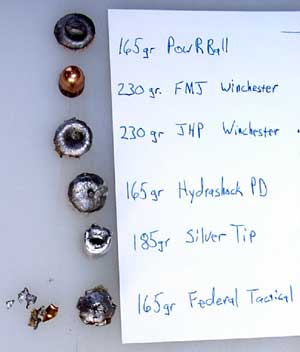 But the basic issue still remains: what is "good" performance?
But the basic issue still remains: what is "good" performance?
Since the idea of bullet testing for a custom bullet maker is to see how a certain bullet compares with the "typical" over-the-counter competition, my way of determining performance levels is to set up a standard medium that will remain consistent for my tests, both now and in the future, and then use one of those "typical" bullets as a standard for comparison. The "art", if you will, is in judging what is a reasonable, typical standard bullet. Once you have made that decision, the rest is pure science! For example, suppose I am testing a .224 varmint bullet that I just developed. The goal is to blow up prairie dogs as thoroughly as possible. We want target accuracy, so first that has to be achieved by making sure the components are concentric and balanced, the load is right for the gun, and the bullet length and weight is right for the barrel that most of my customers will use. If some of them use a 6 twist and some use a 12, I have to decide up front which customers I need to satisfy with this bullet, and make sure I have another one for the others. Once I have the basics down, then I can work on the specific features that might make my bullet blow up faster and ricochet less often (or, we hope, never) than the typical factory bullet that these same customers can buy right now, probably for a lot less money. If I'm going to be able to charge a premium I have to justify the cost with the better performance, which in this case means the bullet will blow up and not ricochet when it hits the ground or the varmint. So, maybe I'll use serrations in the jacket, a pre-fragmented core, a pear-shaped hollow cavity filled with silicone fluid and capped with a bullet ball...whatever. The details are not important, because the testing is our concern and it will be the same. First, I will fire a reasonable number of "standard" bullets into my test medium at the same range and velocity that I will use for my own bullet. I normally figure that five to ten shots, while woefully short of statistical relevance for a serious scientific test, is enough to establish whether we are getting consistent performance at a given speed. If I use the same medium, the same gun and range and velocity, and I get three out of five blowing up and two penetrating without any significant change, then I know that I have to either find another test bullet or change the load and try again. This seldom happens, but it can. If your test "standard" bullet isn't consistent, there isn't much point in using it for comparison. Then, after I have established that I have a "normal" bullet that people are actually likely to use and it consistently performs in some specific way in my test medium, then I can load up my own bullets to the same general velocity and shoot them out of the same gun, from the same range, into the same medium. Now I can really compare apples and apples! I have eliminated all the variables that it is practical and cost-effective to eliminate, and can compare what my bullet does with what some standard, over-the-counter bullet did in exactly the same circumstances. Does it matter exactly what either one did? Not really, in broad terms. If the factory bullet didn't expand at all, and mine does, then for this purpose mine is better. We know the factory bullet is in daily use for the intended purpose, so we have to presume it is satisfactory for that purpose or most people would not buy it again. Regardless of how it performs in my SIM-TEST media, the fact is that it probably performs reasonably well in real life. So whatever it does in SIM-TEST can be translated as "standard" performance, regardless of whether it is exactly the same as what happens when it hits a varmint. Does this mean I could also shoot the same bullets into clay, or water-soaked paper, or for that matter, into a gunny-bag full of sand, and consider that standard performance for purpose of comparision with my bullet? Yes, it does. The problem is, the medium has to remain the same all the way through the tests, and the medium has to at least be vaguely similar to the actual target so that we don't push the performance so far off the chart that we can't see any difference even if there might have been one in real life. Firing into a bag of sand will probably blow up any of the bullets, even ones that might make it through a varmint and whizz off over the head of the farmer, riding his tractor just over the hill beyond line of sight. So you'd think the bullet was doing great, both the standard and yours. In fact, the medium was just too far beyond real life to show the problem. If my bullet blows up after penetrating only 3 inches and the factory bullet blows up after penetrating 6 inches, and most varmints are less than 6 inches through the torso, it is at least a pretty good indication that my bullet is, in this instance, performing better. Keep in mind that if we were talking about shooting deer, the opposite would be true. In fact, we really wouldn't want either bullet to be blowing up, because most likely the standard deer bullet would penetrate and expand to some degree in eight or ten inches of travel through the test media, and my competitive and hopefully better bullet ought to expand more and yet retain more of its weight, at least according to what seems to be the popular opinion of good deer bullet performance. That is another aspect of the "art" of testing bullets. You need to know what your customers will think is good performance, regardless of what you think. If you want to try to change their minds, good for you. But you'll spend a lot of money educating people when you might have been selling them products that they already want. This is a malady that can affect the inventor to his market detriment: you are the innovator, and so you KNOW better than the average shooter what works and what doesn't. Maybe so. But if the average fellow wants a bullet that expands twice its caliber and retains at least 90% of the original weight after passing about 3/4 of the way through the average mule deer, and you think that it would be better if the bullet passed all the way through both sides and didn't expand quite that much, how wise is it to insist on imposing your views on the market? What you might do instead is develop two bullets. Develop one that does exactly what your customers want right now, and does it better (retains more weight, perhaps, or starts expanding at a somewhat lower velocity and doesn't blow up at a somewhat higher one, for instance). Develop another one that does things your way. Promote both of them, one as an alternative. This takes some thinking and some planning, but it gives your idea a chance on the market while at the same time uses the popular thinking to finance it! And there is always the chance...slim, you say, but still possible...that your idea is wrong and all those deer hunters have it right after all! Or, more likely, you are both right under difference circumstances. The point is, establish what you feel is a reasonable goal for performance, in very general terms, and then work to maximize that performance without setting up impossible or arbitrary numbers. So often a custom bullet maker may stymie himself in his pursuit of perfection by starting out with a completely arbitrary goal, and then spending an undue amount of time and money trying to hit some number (such as a "BC" figure) when really, all they need to do is come up with something "better", not a specific number. I've fallen prey to this thinking myself many times. I looked at the published BC figures for long range target bullets in some caliber and then decided on some number that was higher, and spent too much time attempting to get to it, when I already had something that worked just fine that happened to have a different BC under certain test circumstances. Another example would be when I tried to hit a certain over all length and a certain arbitrary weight and have a specific tip closure on my bullet, all at the same time. It was a struggle, and I make a lot of superior bullets that I tossed aside just because they were lighter or heavier or the tip was bigger or the length was shorter or some such foolishness. Challenging the rules of physics is a losing proposition unless you are Einstein, and even he just proved that Newton was right enough for practical purposes if you reduce the energy levels to those we observe in everyday life. Those of us who want to become the minor Einstein of custom bullet making sometimes forget that a big change in one parameter in order to gain some particular level of number may well destroy the practical utility of the design. Going for the highest possible BC can result in a bullet that is virtually unfirable in anything but a super fast twist gun, and high BC can also result in poor expansion, bending of the long ogive instead of mushrooming on impact. When we are testing bullets, we first have to recognize and set practical goals. Then we have to determine what to use as a comparison, in a readily-available "standard" bullet. And finally, we need to have the test situation as unchangeable and constant as possible for this and all future tests, eliminating the variables as much as we can, so that all we are comparing is our bullet and "their" bullet. A good test medium is an important aspect. Apples and apples. No worms. By the way, when you fire a target velocity solid 22 into the test media, don't be surprised to find that is hard to see where the bullet went in. You can fire a dozen 22 LR bullets into SIM-TEST and barely notice anything different about the block. I used half of a ten pound block, sliced with a butcher knife into three equal sections about 3 inches thick, so I had a row of 9 inches of material. I put a piece of thin card stock between them and pushed them back together, and fired a number of rounds into the 7-inch wide slabs without really even seeing any impact other than the slight flicker of the cardboard ends sticking out. When I separated the blocks, there were good sized holes in the paper between the first two blocks, and all the bullets were found neatly lined up in the third block. The material closed back around the "wound" channel so you could just almost tell there had been a hole, if you looked closely. That is so close to what I've seen in actual wounds with a .22 in muscle tissue. The bullets look like you could load and shoot them again, except for rifling marks. Unless the bullet strikes bone or enters a body cavity, it isn't likely to show much more damage in "real life" than this. Not that it wouldn't hurt like the devil! Unfortunately, most of us do not have nine inches of solid muscle tissue and if we did, the odds are that if we were shot with a 22 LR bullet it would hit somewhere else, anyway. You can, however, compare what a hollow point and a solid (this was a solid, by the way) do in SIM-TEST and be fairly well assured that, if all else were the same, that any differences in real life performance would "track" between the results in the test media. While this may be true of wet phone books and duct seal or clay, you generally get a much more dramatic hole size than you would in "real life" or in SIM-TEST. That isn't good or bad, just something to keep in mind when drawing conclusions about your tests. | |
|
|
| Home Page | Price List | E-Mail Sales | Site Map | New Products | Terminology | |
| Retirement | Specials | Real Estate | Software | How to swage | Classified Ads | Feedback |